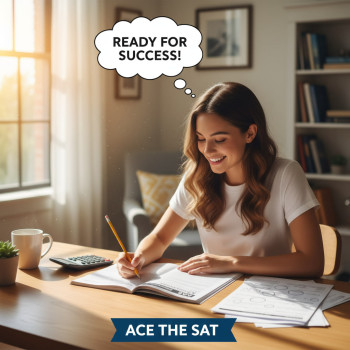Why the Digital SAT matters for STEM hopefuls
If you or your child is aiming for a STEM major — engineering, computer science, physics, biochemistry, or any of the many intersections of science, technology, engineering, and math — the Digital SAT is no longer a distant rumor. It’s the reality many colleges now consider as they evaluate applicants. Beyond the obvious: that strong math performance signals quantitative readiness, the Digital SAT also changes how students demonstrate problem-solving, time management, and adaptability — all traits STEM programs look for.

What admissions officers actually look for
Admissions readers see the SAT score as one piece of a larger story: grades, coursework rigor (AP, IB, honors), letters of recommendation, extracurriculars (research, robotics, coding clubs, internships), and essays. For STEM applicants, the math and problem-solving portions of the SAT often carry extra weight — not because they are infallible predictors, but because they offer a standardized glimpse into a student’s quantitative reasoning across a common measure.
That said, many selective programs take a holistic view. A slightly lower SAT score can be mitigated by strong math and science coursework, research experience, or a compelling personal narrative. Conversely, an excellent SAT score can elevate an application if other elements are strong but less obvious.
How the Digital SAT differs — and why that matters for STEM
The Digital SAT changed how questions are delivered, time is managed, and analytic insights are presented. For STEM-minded students, three changes are particularly important:
- Adaptive sections and pacing: Digital delivery often adapts within section blocks, so consistent accuracy matters more than tactics that relied on skipping-and-returning on paper tests.
- Calculator availability: Calculators are allowed for most of the math section on the digital platform, shifting the balance toward strategy and higher-order reasoning.
- Report clarity: Digital score reports provide clearer content-area breakdowns, which can guide focused study in algebra, problem solving, and advanced math topics.
For STEM applicants, this means practicing in a digital environment is non-negotiable: become comfortable with the device, the navigation, and the specific way questions are presented. Practice that replicates the test environment reduces technical surprises and lets students showcase their quantitative skills under the conditions colleges expect.
What STEM programs value beyond the math score
Here’s a friendly reality check: while the Math score is visible, it’s not the only metric for STEM. Programs want to see:
- Challenging coursework (multivariable calculus is rare in high school, but AP Calculus BC, AP Physics C, AP Computer Science A, and AP Chemistry are meaningful).
- Hands-on experience (science fairs, research internships, summer programs, coding projects, open-source contributions).
- Evidence of sustained interest (long-term project, leadership in a STEM club, or a portfolio of work).
- Strong letters that speak to persistence, curiosity, and teamwork in STEM contexts.
Practical prep strategy: a STEM-focused study plan
This is where preparation becomes craft. The following plan is tailored to the digital format and to the demands of STEM admissions. It assumes roughly 3–6 months of preparation depending on starting score and target schools, but you can scale the timeline.
1) Baseline + environment
Take an official digital practice test early — not as a judgment, but as a diagnostic. Pay attention to:
- Which math content areas cause errors (algebra, geometry, trigonometry, data interpretation).
- Time per question and whether the student feels rushed.
- How comfortable they are using on-screen tools like the equation editor, ruler, or answer eliminator.
2) Targeted math work — quality over quantity
Focus on precision in these areas:
- Algebraic manipulation and function behavior: linear, quadratic, exponential.
- Problem solving with ratios, proportions, unit analysis — indispensable in physics and engineering contexts.
- Intermediate topics: systems of equations, interpretation of complex word problems, and basic statistics.
- Advanced readiness: if aiming for top engineering programs, ensure mastery of trigonometric identities and precalculus reasoning.
3) Practice under realistic digital conditions
Regularly take timed, full-length digital practice tests. The digital experience changes strategy: adaptive blocks reward consistent accuracy, and the on-screen interface affects how you mark and revisit questions.
4) Integrate project-based STEM evidence
Admissions committees love specific accomplishments. Spend time building or documenting a project: a coding portfolio, an original research poster, an independent lab investigation, or an engineering build. These show initiative and provide concrete material for essays and interviews.
5) Fine-tune test-day logistics
Make sure device compatibility, Bluebook app familiarity, and break-management are practiced. It’s a small thing that reduces stress on test day and helps performance.

How to interpret your Digital SAT results for STEM applications
Digital score reports often break results into sub-areas of math and reading/writing. For STEM students, dig into the math sub-scores: they reveal strengths and weaknesses that can guide both remedial study and application storytelling.
| Score Area | What It Signals | Action for STEM Applicants |
|---|---|---|
| Math — Algebra & Functions | Core readiness for calculus and modeling | Build fluency with equation manipulation and function interpretation; work problems with real-world contexts. |
| Math — Problem Solving & Data | Ability to interpret data, graphs, and statistical reasoning | Practice with data sets, learn to quickly read charts and tables, and apply unit analysis. |
| Math — Geometry & Trig | Spatial reasoning and trigonometric fluency | Review identities and geometric problem solving; use visual aids and coordinate geometry problems. |
Navigating test-optional policies and when to submit scores
Some colleges remain test-optional, others have reinstated score requirements, and policies continue to evolve. For STEM applicants, think strategically:
- If your SAT math score is demonstrably strong (competitive for your target schools), submitting it can help your application stand out.
- If your score is below the typical range for admitted STEM students at your chosen schools, consider focusing on coursework, AP scores, research, and a strong quantitative transcript instead.
- For schools that emphasize standardized metrics, a robust Digital SAT score may unlock scholarship opportunities or placement advantages.
When in doubt, contact admissions offices with specific questions — they can tell you how they weigh digital SAT scores for STEM majors. Also keep an eye on schools’ application websites for the latest policy updates and any program-specific requirements.
Crafting the rest of your STEM application
Think of the SAT as one instrument in an orchestra. The essay, letters, coursework, and extracurriculars are other instruments. For STEM, coordinate them into a coherent performance:
Personal statement and supplemental essays
Use essays to show the thinking behind your quantitative achievements: describe a problem you solved, a research question you pursued, or a project that taught you to iterate and learn from failure. Concrete specifics — a piece of code, a lab result, a building that didn’t stand at first — make essays memorable.
Letters of recommendation
Ask recommenders who can speak to your analytical thinking: a math teacher who watched you grapple with proofs, a research mentor, or a team coach who can testify to your collaborative problem-solving. Give recommenders context: share your intended major, notable projects, and the story you want to tell.
Coursework and grades
Colleges trust high-school transcripts. Advanced math and science classes with strong grades send a powerful signal. If there’s a mismatch between your coursework rigor and standardized scores, be ready to explain how you’re addressing gaps — via summer courses, tutors, or research.
Practice resources and study tactics that actually work
Not all practice is equal. For the Digital SAT and STEM preppers, these approaches produce measurable gains:
- Quality over volume: focused review of weak content areas is better than random question sets.
- Active review: explain solutions aloud or teach a friend — teaching reveals gaps faster than rereading.
- Timed mixed practice: alternate between pure content drills and mixed, timed sections to simulate adaptive testing pressure.
- Project-based reinforcement: use math to solve a project (data analysis for a science fair, coding a simulation) to make skills stick and give you application material.
The role of tutoring — when and why to invest
Tutoring can accelerate progress if it’s targeted. Personalized 1-on-1 guidance helps students stay accountable, build a plan that addresses specific weaknesses, and practice test strategies tailored to the digital platform. Tutors who combine content expertise with digital-SAT familiarity can shave weeks off preparation time by keeping practice disciplined and efficient.
Sparkl’s personalized tutoring can fit naturally here: their approach—1-on-1 guidance, tailored study plans, expert tutors, and AI-driven insights—helps students convert raw potential into measurable score improvements while preserving time for projects and coursework that strengthen STEM applications.
Test-day best practices for digital delivery
Beyond content, the test-day routine can make or break performance. Here’s a practical checklist:
- Device readiness: charge, check Bluebook compatibility, and bring a backup charger if allowed.
- Simulation: have at least two full mock tests on the same type of device with the same settings you’ll use on test day.
- Break strategy: know how long breaks are and plan snacks and quick mental resets.
- Sleep and nutrition: treat test day like a competition day — rest well the two nights before and eat a balanced breakfast.
Common myths and smart clarifications
Let’s debunk a few myths students often hear:
- Myth: “You need a perfect SAT to get into top STEM programs.” Reality: Many admitted students balance very high coursework rigor, research, and recommendation quality. Scores are important but not the sole determinant.
- Myth: “Digital tests are easier, so practice isn’t necessary.” Reality: Familiarity with the digital interface and adaptive format is essential. Practice remains key.
- Myth: “Only math matters for STEM.” Reality: Communication, writing, and interdisciplinary thinking are crucial — especially for collaborative research and interdisciplinary fields like bioinformatics.
Real student examples — how scores fit into the bigger picture
Here are short, anonymized vignettes that illustrate how Digital SAT scores interact with other application strengths.
- Student A: Strong AP coursework (Calc BC, Physics C), a summer research internship, and a Math score slightly above the program median. The SAT reinforced an already-convincing academic record and helped secure a scholarship tied to quantitative readiness.
- Student B: Exceptional coding portfolio and research poster but a middling SAT score. The student strategically submitted AP scores, wrote essays focused on research process, and used strong recommendations to demonstrate technical depth. Admissions respected the project evidence.
- Student C: High SAT Math score but fewer advanced STEM courses. The score helped spark interest from programs offering bridge courses, but admissions asked for a plan to take advanced coursework before matriculation.
Putting it all together: an action plan for this month
If you’re reading this with six months to application season, here’s a compact calendar to get moving:
- Month 1: Diagnostic digital practice test, identify 3–4 weak content areas.
- Month 2–3: Focused content blocks (algebra, data interpretation, trig), two timed section practices each week.
- Month 4: Full-length digital practice tests every 10–14 days; start project documentation and draft essays tied to STEM experience.
- Month 5: Final content clean-up, take one to two official practice tests under test-day conditions, finalize recommenders and essay drafts.
- Month 6: Test day, then pivot to applications: polish personal statement, compile portfolio items, and prepare for interviews if needed.
Where tutoring fits
If time is limited or a student is aiming for selective programs, targeted tutoring during Months 2–4 is often the highest-impact investment. Tutors can compress study time by keeping focus on what’s most likely to move the score needle and by aligning practice to the digital format.
Final thoughts for parents and students
Preparing for the Digital SAT as a STEM applicant is both technical and human. It’s technical because content knowledge and test strategies matter. It’s human because curiosity, resilience, and a love of discovery are what admissions officers ultimately want to cultivate in their programs. Use the Digital SAT to showcase quantitative readiness, but remember to tell a full story: the projects, the late nights debugging code, the lab bench that finally yielded results, the teamwork that made a robotics competition possible.
If you’d like a guided, personalized approach that combines expert tutors with AI-driven insights and a study plan tailored to both the Digital SAT and your STEM application story, consider exploring personalized options like Sparkl. The right mentorship can help balance test prep with meaningful project work so you arrive at application season confident and ready to shine.
Start early, practice smart, and keep building projects that light you up. STEM admissions reward curiosity and consistent effort — and the Digital SAT is one more way to let that work speak for itself.
Good luck — you’ve got this.














No Comments
Leave a comment Cancel